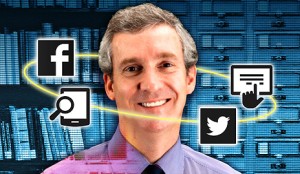Michael Dula recently began his appointment as chief technology officer for the Yale University Library, which is one of the largest university libraries in North America. In this newly created role, he will develop a technology strategy for the University’s 18 different libraries, which house over 12.5 million volumes.
Prior to coming to Yale, Dula worked at Pepperdine University, where he began as a consultant. In 2006, he accepted a full-time position at Pepperdine as director of digital initiatives for the university’s libraries. In addition to managing central library technology systems, he was actively engaged in implementing new tools for research and learning, including digital content collections, scholarly publishing, podcasting, and social computing models.
Before working at Pepperdine, Dula enjoyed a 14-year career as a consultant, developing technology plans for various museums, universities, and non-profit organizations such as the Getty Trust.
Dula recently talked with YaleNews about how libraries are adapting to the digital age. Here is an edited transcript of that discussion.
What is the role of the physical library in the digital age?
Admittedly, there is a vast amount of information available online. However, the physical library continues to be relevant, since it meets the demand for a quiet place to focus, study, and do research.
Also, modern libraries complement digital information, since a big part of what libraries do is purchase electronic resources to make them available to our patrons for free. Although a lot of information is free online, it is not necessarily accurate and complete information. Librarians are well suited to help people to navigate and identify credible electronic data.
Furthermore, the Yale libraries provide access to a wealth of material that is not online – for instance special collections that are unique to the University.

According to Michael Dula, chief technology officer for the Yale Library, making digital resources available to patrons for free is a big part of a modern library's mission. (Photo illustration by Michael Helfenbein)
How is the Yale University Library using social media to engage patrons?
We actively use Facebook and Twitter to engage our patrons about many things from our increasingly expanding digitized resources, to study breaks hosted by our libraries such as the Center for Science and Social Science Information.
In the future I imagine that we will leverage social media to help us crowdsource the identification of a collection or cataloguing information, or for recapturing lost information.
For example, it is typical for a library to begin digitizing historic photos from its archives, only to discover that there are many unknown subjects — particularly people, but also events — depicted. Opening up such a collection to tagging or comment by interested viewers such as alumni and faculty often yields a wealth of information.
What are some unique technological resources that the library provides for the Yale community?
A very large portion of what the library now acquires is electronic information, such as online journals and databases. We offer free access to these resources for Yale students, faculty, and staff.
For instance, the library purchased access to the Vault Career Insider, one of the largest, most comprehensive online career resources available. The library also recently acquired institutional access to EndNote, allowing anyone at Yale to freely download this bibliographic and publishing solution application.
In addition, the library is aggressively acquiring online books, such as the recently released Project Muse eBooks collection, providing our patrons access to more than 14,000 online books from some of the country¹s leading university presses.
What are your priorities as chief technology officer for the Yale University Library?
One priority is to develop a strategic infrastructure that supports the digitization of the library’s collections. My goal is to establish a universal set of standards for how we digitize items, and to ensure that our collections are fully catalogued and permanently preserved. Ideally, the infrastructure that we build will be robust enough to support a wide variety of digital collection initiatives across the library system and the University as a whole.
Another priority is to integrate Yale’s libraries as fully as possible into the academic programs of the University, including inside the classroom. As the classrooms around Yale become increasingly wired, we want to make items from the library’s special collections and other resources more readily available for faculty to use during their seminars.
How does technology enable the library to serve the global community beyond the University’s campus?
The library has an important role in the global scholarly community. We have unique collections that a vast number of researchers visit campus to access. It is important that our digital collections are catalogued appropriately so that they are easily discoverable via popular search engines so that an even larger portion of the world will beat a path to our virtual door, if not our actual one.
– By Kianti Roman
*Source: Yale University
